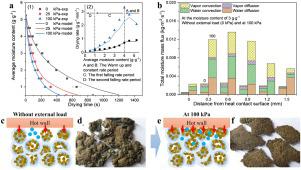Process Safety and Environmental Protection ( IF 7.8 ) Pub Date : 2021-08-27 , DOI: 10.1016/j.psep.2021.08.021 Dexiao Ma 1 , Guozhao Ji 1 , Dong Wang 1 , Aimin Li 1

|
Conductive drying is widely used in sludge management for emission reduction and energy recovery. However, interfacial vapor film between sludge and hot wall inhibits drying efficiency. This study employed external load to reinforce the contact of sludge with hot wall for facilitating interfacial heat transfer. Subsequently, a drying model was developed for heat and mass transfer mechanism analysis. The influence of external loads was explored on conductive drying behavior at 180 °C and 0, 25, 100 kPa. The drying rates were increased with external load. The drying process consisted of the warm-up, constant rate, and two falling rate periods. Without external load, moisture migration was dominated by liquid water diffusion induced by capillary force in the first falling rate period. However, at 100 kPa, the convective flow of water and vapor dominated the moisture migration in the first falling rate period due to increased interfacial heat transfer, evaporation rate, and gas pressure. Then vapor diffusion was predominant owing to enhanced gas diffusivity. Besides, this study provided essential information on design optimization of industrial applications, such as moisture content prediction for searching for equilibrium points between energy consumption and resource recovery and the critical factors for enhancing moisture migration.
中文翻译:

通过施加外部载荷加强污泥和热壁之间的接触以增强传导干燥:传热和传质分析
传导干燥广泛用于污泥管理以减少排放和能量回收。然而,污泥和热壁之间的界面蒸汽膜抑制了干燥效率。本研究采用外部载荷来加强污泥与热壁的接触,以促进界面传热。随后,开发了用于传热和传质机制分析的干燥模型。在 180 °C 和 0、25、100 kPa 下探索了外部负载对导电干燥行为的影响。干燥速率随着外部负载的增加而增加。干燥过程包括预热、恒速和两个降速期。在没有外部载荷的情况下,水分迁移主要是由毛细管力引起的液态水扩散在第一下降率期间主导的。然而,在 100 kPa 时,由于界面传热、蒸发率和气压增加,水和蒸汽的对流在第一下降率期间主导了水分迁移。然后,由于增强的气体扩散性,蒸汽扩散占主导地位。此外,本研究为工业应用的设计优化提供了重要信息,例如用于寻找能源消耗和资源回收之间平衡点的含水量预测以及促进水分迁移的关键因素。



























 京公网安备 11010802027423号
京公网安备 11010802027423号